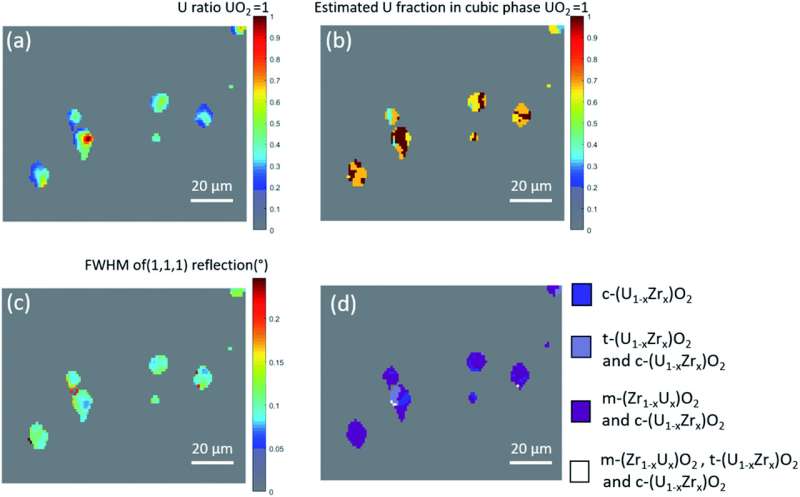Chernobyl clean-up could be helped by new X-ray analysis approach

On the 35th anniversary of one of the world's worst nuclear disasters, new research has been published that could help to contain and clean up the most dangerous radioactive materials that still remain at the site in Chernobyl.
The study, led by Dr. Claire Corkhill from the University of Sheffield's Department of Materials Science and Engineering, has employed a new approach of using ultrabright X-rays to better understand the hazardous waste that has been left behind inside the nuclear reactor.
The technique provides proof of concept for the first time that using ultrabright X-rays can yield rich chemical information on some of the most dangerous materials left at Chernobyl and provide a safe way of analyzing them.
Using ultrabright X-rays has also enabled the team to forensically unravel how nuclear fuel at the site transformed into a lava-like substance immediately after the disaster, which has solidified in large masses and are obstructing decommissioning efforts.
The most dangerous materials that remain inside Chernobyl are so hazardous that only a very limited number of samples have been analyzed. This means that until now scientists have been unable to gain a deep insight into their properties and this is hampering efforts to safely contain or remove the materials from the disaster zone.
The researchers studied simulant Chernobyl material, created using state-of-the-art facilities at Sheffield designed to support nuclear decommissioning and disposal, with two of the world's brightest microscopes—called X-ray synchrotrons—in Switzerland and the U.S.. Here, they were able to measure very small samples of their material and identify uranium-containing features that were one twentieth of the size of a human hair.
By building 2D chemical images of these uranium features, the team were able to reconstruct the timeline of events that occurred in the moments immediately after the accident, during the formation of the melted down nuclear fuel.
Testing the technique on the simulant Chernobyl material has provided proof of concept that the method could be used to safely analyze real samples from Chernobyl like never before.
Dr. Claire Corkhill, EPSRC early career research fellow and reader at the University of Sheffield, said: "Like a forensic analysis of a crime scene, the chemical analysis performed on our simulant materials allowed us to piece together the last moments of the Chernobyl nuclear fuel as it melted together with other components in the reactor to form a volcanic-like lava. Our analyzes are consistent with the limited data available on real samples, which is extremely exciting."
The level of detail gained using these materials and techniques opens up a world of possibilities to develop a deeper understanding of these materials that has not previously been possible due to their high levels of radioactivity. This is a necessity for developing clean-up technologies for the ongoing decommissioning operations at Chernobyl.
Dr. Corkhill added: "Understanding the formation and subsequent chemical behavior of these materials inside the reactor over the last 35 years is key to building a complete understanding of nuclear fuels in accident scenarios. Our study shows that this information can be obtained using extremely small samples, which paves the way for analysis of real Chernobyl and Fukushima nuclear melt-down fuels. Using such small samples will drastically lower the hazard associated with their analysis and opens up extremely exciting possibilities to support the clean-up operation."
More information: Hao Ding et al. Safely probing the chemistry of Chernobyl nuclear fuel using micro-focus X-ray analysis, Journal of Materials Chemistry A (2021). DOI: 10.1039/D0TA09131F
Journal information: Journal of Materials Chemistry A
Provided by University of Sheffield




















